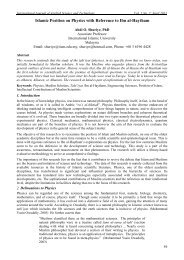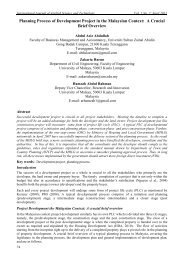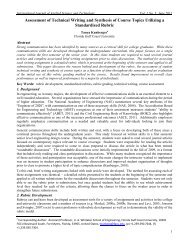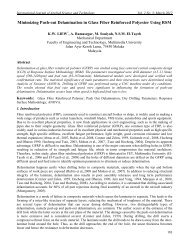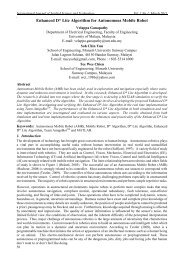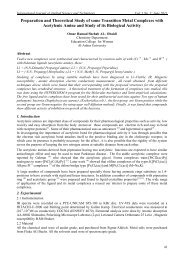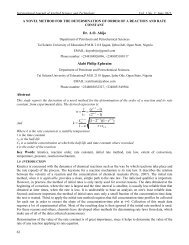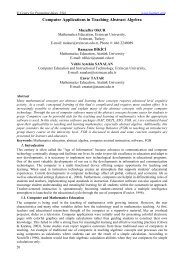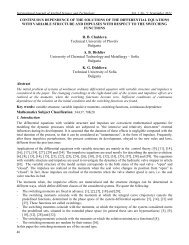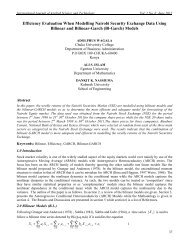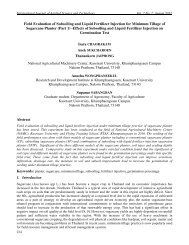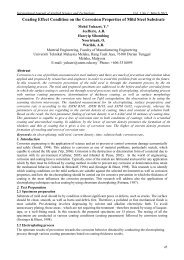Computational Fluid Dynamics Simulation of the Flow Field in Wood ...
Computational Fluid Dynamics Simulation of the Flow Field in Wood ...
Computational Fluid Dynamics Simulation of the Flow Field in Wood ...
You also want an ePaper? Increase the reach of your titles
YUMPU automatically turns print PDFs into web optimized ePapers that Google loves.
International Journal <strong>of</strong> Applied Science and Technology Vol. 2 No. 7; August 2012<br />
<strong>Computational</strong> <strong>Fluid</strong> <strong>Dynamics</strong> <strong>Simulation</strong> <strong>of</strong> <strong>the</strong> <strong>Flow</strong> <strong>Field</strong> <strong>in</strong> <strong>Wood</strong>-Fired Bakery<br />
Ovens<br />
Fabião Armando Manhiça<br />
Department <strong>of</strong> Chemical and Biological Eng<strong>in</strong>eer<strong>in</strong>g<br />
Chalmers University <strong>of</strong> Technology<br />
S-412 96 Go<strong>the</strong>nburg, Sweden<br />
Carlos Lucas<br />
Department <strong>of</strong> Chemical Eng<strong>in</strong>eer<strong>in</strong>g<br />
Eduardo Mondlane University<br />
Cp 157, Maputo, Mozambique<br />
Tobias Richards<br />
School <strong>of</strong> Eng<strong>in</strong>eer<strong>in</strong>g, University <strong>of</strong> Borås<br />
S-50190 Borås, Sweden<br />
Abstract<br />
The circulation <strong>of</strong> hot gases with<strong>in</strong> a bakery oven is used to describe and predict <strong>the</strong> exchange <strong>of</strong> heat and its<br />
<strong>in</strong>fluence on <strong>the</strong> f<strong>in</strong>al product. A bi-dimensional model was used, toge<strong>the</strong>r with a CFD model, to estimate <strong>the</strong> flow<br />
pattern <strong>in</strong>side an oven by vary<strong>in</strong>g <strong>the</strong> velocity <strong>of</strong> <strong>the</strong> airflow <strong>in</strong> order to simulate changes <strong>in</strong> <strong>the</strong> combustion<br />
chamber. Acceptable agreement was found <strong>in</strong> <strong>the</strong> comparison between <strong>the</strong> models and <strong>the</strong> measured<br />
temperatures. The <strong>in</strong>let velocity and <strong>the</strong> geometry affect <strong>the</strong> flow pattern <strong>in</strong> a bak<strong>in</strong>g oven. Low velocity cause low<br />
levels <strong>of</strong> circulation, which implies better conditions <strong>in</strong> <strong>the</strong> bak<strong>in</strong>g process. High velocities <strong>the</strong> temperature<br />
decreases <strong>in</strong> <strong>the</strong> oven due to excess air even with a high recirculation <strong>of</strong> gases. Dur<strong>in</strong>g <strong>the</strong> feed<strong>in</strong>g process, <strong>the</strong><br />
overall heat transfer was also affected by a changed effective <strong>the</strong>rmal conductivity and recirculation <strong>of</strong> hot gases<br />
<strong>in</strong> <strong>the</strong> bak<strong>in</strong>g oven.<br />
Keywords: flow pattern, airflow, physical modell<strong>in</strong>g, wood-fired bakery oven<br />
1. Introduction<br />
The performance <strong>of</strong> a wood-fired bakery oven (WFBO) depends, to a large extent, upon <strong>the</strong> efficiency <strong>of</strong> <strong>the</strong> way<br />
<strong>in</strong> which energy is converted. Such a system <strong>in</strong>cludes <strong>the</strong> conversion <strong>of</strong> chemical energy <strong>in</strong> <strong>the</strong> fuel to <strong>the</strong>rmal<br />
energy, and <strong>the</strong> efficiency with which <strong>the</strong> <strong>the</strong>rmal energy is transferred to <strong>the</strong> bak<strong>in</strong>g chamber. The system for<br />
transport<strong>in</strong>g combustion products through a WFBO and <strong>the</strong> types <strong>of</strong> material used <strong>in</strong> <strong>the</strong> construction <strong>of</strong> <strong>the</strong><br />
furnace are important parameters that impact its overall performance. To some extent, short-term variation is<br />
attenuated by <strong>the</strong> storage capacity <strong>of</strong> <strong>the</strong> brick walls. Figure 1 shows a common design <strong>of</strong> a WFBO <strong>in</strong><br />
Mozambique.<br />
1
© Centre for Promot<strong>in</strong>g Ideas, USA www.ijastnet.com<br />
Figure 1: Cross-section <strong>of</strong> a semi-direct, wood-fired bakery oven.<br />
Design<strong>in</strong>g an optimum bakery oven requires an understand<strong>in</strong>g <strong>of</strong> <strong>the</strong> complex <strong>in</strong>teraction between <strong>the</strong> different<br />
processes that occur, such as: combustion; heat transfer and fluid flow <strong>in</strong> <strong>the</strong> furnace and <strong>the</strong> construction<br />
material.<br />
The combustion process is dependent on <strong>the</strong> physical-chemical properties <strong>of</strong> <strong>the</strong> fuel (e.g. size, shape, density and<br />
moisture content), amount <strong>of</strong> fuel and mode <strong>of</strong> air supply (primary and secondary air). The conditions <strong>of</strong> <strong>the</strong><br />
immediate environment <strong>of</strong> <strong>the</strong> surround<strong>in</strong>gs, such as temperature, w<strong>in</strong>d, particle size and humidity are also<br />
important; some <strong>of</strong> <strong>the</strong>se aspects have been <strong>the</strong> objective <strong>of</strong> previous studies on <strong>the</strong> combustion <strong>of</strong> biomass.<br />
Measur<strong>in</strong>g <strong>the</strong> heat released us<strong>in</strong>g a calorimeter was <strong>in</strong>vestigated by modell<strong>in</strong>g fire growth and <strong>the</strong> endurance <strong>of</strong><br />
<strong>the</strong> wood structure us<strong>in</strong>g <strong>the</strong> rate <strong>of</strong> burn<strong>in</strong>g (Tran & White, 1992). The results show that <strong>the</strong> burn<strong>in</strong>g rate depends<br />
on several factors that complicate <strong>the</strong> modell<strong>in</strong>g <strong>of</strong> wood combustion, e.g. <strong>the</strong> variability <strong>of</strong> material between, and<br />
with<strong>in</strong>, wood species, <strong>the</strong> approximation necessary when modell<strong>in</strong>g <strong>the</strong> chemical properties and <strong>the</strong> moisture<br />
content, along with external factors, such as <strong>the</strong> boundary conditions. <strong>Fluid</strong> dynamic <strong>in</strong> wood combustion research<br />
present a method for design<strong>in</strong>g small-scale model experiments for optimiz<strong>in</strong>g <strong>the</strong> geometry <strong>of</strong> wood-burn<strong>in</strong>g<br />
chambers (Baillifard et al, 2008). The Reynolds number <strong>in</strong> <strong>the</strong> combustion chamber was identified as play<strong>in</strong>g an<br />
important role because it not only <strong>in</strong>fluences <strong>the</strong> flow pattern <strong>of</strong> <strong>the</strong> air but also <strong>the</strong> way <strong>in</strong> which it is mixed. Rath<br />
et al., (2003) estimated <strong>the</strong> average values <strong>of</strong> <strong>the</strong> heat <strong>of</strong> pyrolysis <strong>of</strong> wood observ<strong>in</strong>g that an <strong>in</strong>crease <strong>in</strong> <strong>the</strong> char<br />
yield resulted <strong>in</strong> a decrease <strong>in</strong> <strong>the</strong> total endo<strong>the</strong>rmic heat <strong>of</strong> pyrolysis and, eventually, <strong>in</strong> a shift from an<br />
endo<strong>the</strong>rmic to an exo<strong>the</strong>rmic process.<br />
Iso<strong>the</strong>rmal physical modell<strong>in</strong>g is an experimental method that <strong>in</strong>volves small-scale water models to understand<br />
<strong>the</strong> correspondent flow behaviour <strong>in</strong> large units. It could for example be non-iso<strong>the</strong>rmal flow and combustion <strong>in</strong><br />
furnaces or boilers. It enables an opportunity to vary different design parameters, which would be difficult to<br />
perform on a real process plant because <strong>of</strong> <strong>the</strong> cost and <strong>the</strong> risk <strong>of</strong> damage. The range <strong>of</strong> <strong>the</strong> experimental<br />
technique is very large and new techniques are be<strong>in</strong>g developed as new <strong>in</strong>strumentation and material become<br />
available. Physical modell<strong>in</strong>g is a valuable technique for <strong>the</strong> study <strong>of</strong> e.g. combustion flow pattern; pressure and<br />
velocity distributions found <strong>in</strong> simulation <strong>of</strong> mix<strong>in</strong>g and combustion applications (Baranski, 2002; Hwang et al,<br />
2000; Lucas & Blasiak, 2000).<br />
Although a wood-fired bakery oven was used <strong>in</strong> this work, <strong>the</strong> discussion applies to most wood-fired devices.<br />
Bak<strong>in</strong>g is based on simultaneous heat and mass transfer, which cause <strong>the</strong> series <strong>of</strong> physical, chemical and<br />
structural transformations that are essential to <strong>the</strong> quality <strong>of</strong> <strong>the</strong> f<strong>in</strong>al product.<br />
2
International Journal <strong>of</strong> Applied Science and Technology Vol. 2 No. 7; August 2012<br />
It is a great challenge to produce high quality bread because bak<strong>in</strong>g is an irreversible process and production <strong>of</strong><br />
low quality bread is thus economically unfavourable (Chhanwal et al, 2011). <strong>Computational</strong> <strong>Fluid</strong> <strong>Dynamics</strong><br />
(CFD) has been <strong>in</strong>creas<strong>in</strong>gly applied for design and development <strong>of</strong> bak<strong>in</strong>g oven as well as bak<strong>in</strong>g processes<br />
(Boulet et al, 2010; Therdthai et al, 2003 & 2004; Wang & Yan, 2007; Wong et al, 2006), and is a tool which can<br />
predict fluid flow, heat and mass transfer, chemical reactions and o<strong>the</strong>r phenomena. This work was carried out to<br />
understand <strong>the</strong> aerodynamic aspects <strong>of</strong> a WFBO by apply<strong>in</strong>g well proven techniques: bi-dimensional cold flow<br />
physical modell<strong>in</strong>g and CFD modell<strong>in</strong>g. The study <strong>in</strong>cludes how <strong>the</strong> airflow affects <strong>the</strong> flow pattern <strong>in</strong>side a<br />
WFBO and predicts <strong>the</strong> quality <strong>of</strong> <strong>the</strong> produced bread.<br />
2. Modell<strong>in</strong>g and <strong>Simulation</strong><br />
2.1. 2D Iso<strong>the</strong>rmal Physical Modell<strong>in</strong>g<br />
The present study <strong>in</strong>cludes visualization <strong>of</strong> <strong>the</strong> flow <strong>in</strong> <strong>the</strong> bak<strong>in</strong>g chamber <strong>of</strong> <strong>the</strong> wood-fired bakery oven. It was<br />
performed to achieve qualitative <strong>in</strong>formation and measurement <strong>of</strong> <strong>the</strong> flow characteristic. The first step was to<br />
design <strong>the</strong> physical model relative <strong>the</strong> real equipment (scale 1:10). An alum<strong>in</strong>ium plate with a thickness <strong>of</strong> two<br />
millimetres and a width <strong>of</strong> five millimetres was used for <strong>the</strong> two-dimensional model. It was arranged on a<br />
horizontal plane <strong>in</strong> a water table. Three valves controlled <strong>the</strong> velocity <strong>of</strong> <strong>the</strong> recirculation water <strong>in</strong> model and<br />
alum<strong>in</strong>ium powder (with a diameter <strong>of</strong> about 40 µm) was used to visualize <strong>the</strong> flow pattern. The material does not<br />
dissolve <strong>in</strong> water and it has a high reflective factor and could <strong>the</strong>refore be reused almost <strong>in</strong>def<strong>in</strong>itely. The<br />
disadvantage <strong>of</strong> <strong>the</strong> powder is that it tends to s<strong>in</strong>k at long runn<strong>in</strong>g times. The streaml<strong>in</strong>e pattern was possible to<br />
obta<strong>in</strong> by allow<strong>in</strong>g fairly long exposures time, on ASA 100 films as shown on Table 1. If <strong>the</strong> primary aim <strong>of</strong> <strong>the</strong><br />
model is flow visualization, it is important that <strong>the</strong>re is a clear access <strong>of</strong> <strong>the</strong> areas <strong>of</strong> <strong>in</strong>terest.<br />
Table1: Experimental parameters scheduled for bi-dimensional experiments<br />
Water velocity<br />
[m/s] on <strong>in</strong>let <strong>of</strong> <strong>the</strong> 0.020 0.023 0.030 0.038<br />
model<br />
Light regulation 5.6 8 11 5.6 8.0 11 5.6 8 11 5.6 8.0 11<br />
1/2 1/2 1/2 1/2 1/2 1/2 1/2 1/2 1/2 1/2 1/2 1/2<br />
Exposures time (s) 1/4 1/4 1/4 1/4 1/4 1/4 1/4 1/4 1/4 1/4 1/4 1/4<br />
1/8 1/8 1/8 1/8 1/8 1/8 1/8 1/8 1/8 1/8 1/8 1/8<br />
1/15 1/15 1/15 1/15 1/15 1/15 1/15 1/15 1/15 1/15 1/15 1/15<br />
The velocities were calculated from a typical wood consumption <strong>in</strong> wood-fired bakery ovens (18 kg/h) where <strong>the</strong><br />
amount <strong>of</strong> excess air varied between 2 and 4, which is common <strong>in</strong> poor combustion conditions (Lucas & Blasiak,<br />
2000, Nussbaumer, 2003). In <strong>the</strong> velocity calculations it was assumed that <strong>the</strong> combustion <strong>of</strong> wood was complete<br />
and that atmospheric air entered by natural convection to <strong>the</strong> combustion chamber.<br />
2.3. Ma<strong>the</strong>matical Modell<strong>in</strong>g<br />
Turbulent flow without any chemical reaction was assumed for <strong>the</strong> flow <strong>of</strong> hot gases from <strong>the</strong> combustion<br />
chamber to <strong>the</strong> bak<strong>in</strong>g section <strong>in</strong> <strong>the</strong> oven. The turbulent flows are characterized by fluctuat<strong>in</strong>g velocity fields<br />
primarily due to <strong>the</strong> complex geometry and/or high flow rates. The Navier-Stokes equations can be solved directly<br />
for lam<strong>in</strong>ar flows but, for turbulent flows, <strong>the</strong> direct numerical simulation (DNS) with full solution <strong>of</strong> <strong>the</strong><br />
transport equations at all lengths and time scales is too computationally demand<strong>in</strong>g. The reason is that <strong>the</strong><br />
fluctuations can be <strong>of</strong> small scale and have a high frequency, i.e. <strong>the</strong> Re number is below 5000 (Andersson et al,<br />
2009). An alternative is, <strong>the</strong>refore, to transform <strong>the</strong> Navier-Stoker equations on <strong>the</strong> small eddies which directly<br />
simulate <strong>the</strong> Reynolds averag<strong>in</strong>g and filter<strong>in</strong>g processes (Wang and Yan, 2007). The Reynolds-averaged Navier-<br />
Stokers (RANS) equations represent transport equations for <strong>the</strong> mean flow quantities, and are derived by splitt<strong>in</strong>g<br />
<strong>the</strong> <strong>in</strong>stantaneous properties <strong>in</strong> <strong>the</strong> conservation equations <strong>in</strong>to two parts; mean and fluctuat<strong>in</strong>g components. The<br />
most common RANS models employ <strong>the</strong> Bouss<strong>in</strong>esq (eddy viscosity concept, EDC) to model Reynolds stresses<br />
(Andersson et al. 2009; TorII and Yanagihara, 1989). The hypo<strong>the</strong>sis states that an <strong>in</strong>crease <strong>in</strong> turbulence can be<br />
represented by an <strong>in</strong>crease <strong>in</strong> effective fluid viscosity, and that <strong>the</strong> Reynolds stresses are proportional to <strong>the</strong> mean<br />
velocity gradient by this viscosity. Models based on this hypo<strong>the</strong>sis <strong>in</strong>clude e.g. Spalart-Allmaras, standard k-ε,<br />
RNG k-ε, Realizable k-ε, k-ω and its variants (Fluent 6.1 User Guide, 2004).<br />
3
© Centre for Promot<strong>in</strong>g Ideas, USA www.ijastnet.com<br />
To mimic a wood-fired bakery oven, <strong>the</strong> selected model must be valid at low Reynolds number and still <strong>in</strong>clude<br />
turbulence due to <strong>the</strong> complex geometry that cause fluctuation <strong>in</strong> <strong>the</strong> velocity fields. A ma<strong>the</strong>matical model that<br />
can be used to describe <strong>the</strong> flow pattern at this condition is <strong>the</strong> two-equation k-ω, where <strong>the</strong> turbulence specific<br />
dissipation, ω, is used as a length determ<strong>in</strong><strong>in</strong>g quantity. This quantity is def<strong>in</strong>ed by , and it should be<br />
<strong>in</strong>terpreted as <strong>the</strong> <strong>in</strong>verse <strong>of</strong> <strong>the</strong> time scale on which dissipation occurs. The modelled k-equation is: dissipation<br />
occurs. The modelled k-equation is:<br />
⎡<br />
∂κ<br />
∂t + U ∂κ<br />
⎛∂ U j<br />
j<br />
= ν T<br />
+ ∂ U ⎞<br />
j ∂ U<br />
⎤<br />
⎢<br />
i<br />
⎥<br />
∂x ⎜<br />
j ⎝ ∂x J<br />
∂x ⎟<br />
⎣⎢<br />
i ⎠ ∂x J ⎦⎥ − βκω + ∂ ⎡⎛<br />
ν + ν ⎞<br />
T<br />
⎜ ⎟ ∂κ ⎤<br />
⎢ ⎥<br />
∂x j ⎣⎢<br />
⎝ σ κ ⎠∂x j ⎦⎥<br />
And <strong>the</strong> modeled ω-equation is:<br />
∂ω<br />
∂t + U ∂ω<br />
j<br />
= α ω ⎡⎛<br />
∂x j<br />
κ ν ∂ U j<br />
T<br />
+ ∂ U ⎞<br />
j ∂ U<br />
⎤<br />
⎢<br />
i<br />
⎥<br />
⎜<br />
⎝ ∂x J<br />
∂x ⎟<br />
⎣⎢<br />
i ⎠ ∂x J ⎦⎥ − β * ω 2 + ∂ ⎡⎛<br />
ν + ν ⎞<br />
T<br />
⎜ ⎟ ∂ω ⎤<br />
⎢<br />
⎥<br />
∂x j ⎣⎢<br />
⎝ σ ω ⎠∂x j ⎦⎥<br />
(1)<br />
(2)<br />
where <strong>the</strong> turbulent viscosity is calculated from ν T<br />
= κ ω .<br />
An advantage <strong>of</strong> this model compared to <strong>the</strong> more commonly used k-ε model is that it can predict <strong>the</strong> viscous sub<br />
layer near <strong>the</strong> wall more reliable and <strong>the</strong>reby elim<strong>in</strong>at<strong>in</strong>g <strong>the</strong> need to use wall functions except for computational<br />
efficiency. However, <strong>the</strong> low Reynolds k-ω model requires a very f<strong>in</strong>e mesh close to <strong>the</strong> wall with <strong>the</strong> first grid<br />
below y + =5 (Andersson et al. 2009)<br />
2.4. Modell<strong>in</strong>g Assumptions<br />
Two-dimensional flow: The computational time was reduced by tak<strong>in</strong>g a 2-D vertical and longitud<strong>in</strong>al crosssection<br />
<strong>in</strong> <strong>the</strong> central <strong>of</strong> <strong>the</strong> oven as <strong>the</strong> calculation doma<strong>in</strong>. Tak<strong>in</strong>g only <strong>the</strong> thickness <strong>of</strong> <strong>the</strong> brick <strong>in</strong>to<br />
consideration and ignor<strong>in</strong>g <strong>the</strong> sand that normally covers it, fur<strong>the</strong>r simplified <strong>the</strong> geometry. When compared with<br />
<strong>the</strong> cold bi-dimensional physical model no breads were taken <strong>in</strong>to account but when a more realistic flow field<br />
and heat transfer were estimated, eight breads were <strong>in</strong>cluded.<br />
Turbulent flow: The irregular and natural convection <strong>of</strong> <strong>the</strong> air flow and complex geometry meant that turbulent<br />
flow was considered; <strong>in</strong> spite <strong>of</strong> <strong>the</strong> low Re number (Nussbaumer, 2003)<br />
Steady state: The system was assumed to be <strong>in</strong> a steady state so that <strong>the</strong> cold flow physical model could be<br />
compared with <strong>the</strong> ma<strong>the</strong>matical model.<br />
2.5. Boundary Conditions<br />
At <strong>the</strong> combustion chamber: The combustion chamber was only <strong>in</strong>cluded <strong>in</strong> <strong>the</strong> modell<strong>in</strong>g to provide a realistic<br />
flow pattern <strong>in</strong>to <strong>the</strong> bakery oven. Therefore, <strong>the</strong> heat released dur<strong>in</strong>g combustion was modelled as a heat source<br />
<strong>in</strong> <strong>the</strong> combustion chamber to <strong>in</strong>crease <strong>the</strong> temperature <strong>of</strong> <strong>the</strong> <strong>in</strong>com<strong>in</strong>g atmospheric air (298 K). The temperature<br />
had a range <strong>of</strong> 770-850 K measured experimentally on <strong>the</strong> fire-grate lead<strong>in</strong>g <strong>in</strong>to <strong>the</strong> bak<strong>in</strong>g chamber us<strong>in</strong>g an air<br />
flow which corresponds to an amount <strong>of</strong> excess air between 2 and 4 (Nussbaumer, 2003). Heat losses were<br />
modelled as heat transfer through <strong>the</strong> brick wall by conduction. The volume <strong>of</strong> air was based on <strong>the</strong> <strong>the</strong>oretical<br />
amount needed for combustion and <strong>the</strong> different excess air ratios. The velocities were calculated from <strong>the</strong> air<br />
required to burn <strong>the</strong> amount <strong>of</strong> wood measured (18 kg wood /h) and are illustrated <strong>in</strong> Table 2.<br />
The experimental temperature measurement was performance <strong>in</strong> one selected po<strong>in</strong>t (around 0.1m <strong>of</strong> start po<strong>in</strong>t) <strong>in</strong><br />
<strong>the</strong> fire-grate as described by (Manhica et al, 2012).<br />
At <strong>the</strong> wall surfaces: Convective and radiative heat transfer boundary conditions were applied to all outer walls<br />
and to <strong>the</strong> feed<strong>in</strong>g door. Heat flux to <strong>the</strong> wall was computed as<br />
q = h f<br />
4<br />
( T w<br />
−T f ) + q rad<br />
(3)
International Journal <strong>of</strong> Applied Science and Technology Vol. 2 No. 7; August 2012<br />
h f is <strong>the</strong> local heat transfer coefficient <strong>of</strong> <strong>the</strong> fluid (W/m 2 K), T w is <strong>the</strong> wall surface temperature (K), T f is <strong>the</strong> local<br />
fluid temperature (K) and, q rad is <strong>the</strong> radiative heat flux (W/m 2 ). Air, which consists <strong>of</strong> nitrogen, oxygen, small<br />
amount <strong>of</strong> carbon dioxide and o<strong>the</strong>r gases, has been found not show<strong>in</strong>g absorption band <strong>in</strong> those wavelength<br />
regions <strong>of</strong> importance to radiant heat transfer. The walls are <strong>in</strong>sulated with red bricks (0.22 m). The heat loss,<br />
which was calculated from <strong>the</strong> overall heat transfer coefficient that comb<strong>in</strong>es convection and conduction, was<br />
estimated as be<strong>in</strong>g approx. 13.0 W/m 2 K (Birds et al, 2001)<br />
2.6. Modell<strong>in</strong>g Equation<br />
Assum<strong>in</strong>g a two-dimensional turbulent and steady state airflow with<strong>in</strong> <strong>the</strong> oven, <strong>the</strong> heat transfer mechanisms are<br />
described ma<strong>the</strong>matically by <strong>the</strong> equations <strong>of</strong> mass conservation (cont<strong>in</strong>uity equation), momentum conservation<br />
(Navier–Stokes equation) and energy conservation.<br />
Mass conservation (cont<strong>in</strong>uity equation):<br />
∂ρ<br />
∂t = −<br />
⎛ ∂<br />
∂x ρυ x<br />
+ ∂ ∂y ρυ ⎞<br />
⎜<br />
y ⎟ (4)<br />
⎝<br />
⎠<br />
Momentum conservation (Navier–Stokes equation):<br />
∂<br />
∂t ρυ ⎛<br />
x<br />
= −<br />
∂<br />
∂x ρυ xυ x<br />
+ ∂<br />
∂x ρυ ⎞ ⎛<br />
⎜<br />
yυ x ⎟−<br />
∂<br />
⎝<br />
⎠ ∂x τ xx<br />
+ ∂ ∂x τ ⎞<br />
⎜<br />
yx ⎟− ∂P<br />
⎝<br />
⎠ ∂x + ρg (5)<br />
x<br />
∂<br />
∂t ρυ = − ⎛ ∂<br />
y<br />
∂x ρυ xυ y<br />
+ ∂<br />
∂x ρυ ⎞ ⎛<br />
⎜<br />
yυ y ⎟−<br />
∂<br />
⎝<br />
⎠ ∂x τ + ∂<br />
xy<br />
∂x τ ⎞<br />
⎜<br />
yy ⎟− ∂P<br />
⎝<br />
⎠ ∂y + ρg (6)<br />
y<br />
Energy conservation:<br />
⎛∂T<br />
ρc p<br />
∂t +υ ∂T<br />
x<br />
∂x +υ ∂T ⎞ ⎡<br />
⎜<br />
y ⎟ = κ ∂2 T<br />
⎝<br />
∂y ⎠ ∂x + ∂2 T ⎤ ⎡<br />
⎢ ⎥+ 2µ ∂υ 2<br />
⎛ ⎞<br />
x<br />
⎜ ⎟ + ∂υ 2<br />
⎛ ⎞ ⎤<br />
y<br />
⎢ ⎜ ⎟ ⎥<br />
⎣<br />
2 ∂y 2<br />
⎦ ⎣⎢<br />
⎝ ∂x ⎠ ⎝ ∂y ⎠ ⎦⎥<br />
(7)<br />
⎡⎛<br />
+µ ∂υ x<br />
∂y + ∂υ 2<br />
⎞ ⎤<br />
y<br />
⎢⎜<br />
⎟ ⎥<br />
⎣⎢<br />
⎝ ∂x ⎠ ⎦⎥ − 2µ ⎡∂υ x<br />
3 ∂x + ∂υ ⎤<br />
y<br />
⎢ ⎥<br />
⎣ ∂y ⎦<br />
Toge<strong>the</strong>r with <strong>the</strong> <strong>in</strong>itial boundary conditions (velocity, and temperature), <strong>the</strong> equations were solved with Fluent<br />
on ANSYS 12 Workbench. It was found that 1500 iterations were satisfactory to achieve low residuals for all<br />
equations. At <strong>the</strong> end <strong>of</strong> <strong>the</strong> iterations, <strong>the</strong> residuals were reduced to less than 10 -3 <strong>of</strong> <strong>the</strong>ir <strong>in</strong>itial values.<br />
<strong>Simulation</strong>s were carried out to study <strong>the</strong> effects on <strong>the</strong> airflow patterns when <strong>the</strong> velocity <strong>of</strong> <strong>the</strong> air enter<strong>in</strong>g <strong>the</strong><br />
combustion chamber <strong>in</strong> <strong>the</strong> wood-fired bakery ovens was varied accord<strong>in</strong>g Table 2.<br />
Table 2: Velocities used <strong>in</strong> <strong>the</strong> different experiments and <strong>the</strong> correspond<strong>in</strong>g Re number.<br />
Density = 0.23 kg/m3, viscosity = 0.46·10-4 kg/mK, characteristic length <strong>of</strong> <strong>the</strong> <strong>in</strong>let section <strong>of</strong> <strong>the</strong> combustion<br />
chamber = 0.54 m.<br />
Parameter /Unit<br />
<strong>Simulation</strong><br />
#1<br />
<strong>Simulation</strong><br />
#2<br />
<strong>Simulation</strong><br />
#3<br />
<strong>Simulation</strong><br />
#4<br />
<strong>Simulation</strong><br />
#5<br />
<strong>Simulation</strong><br />
#6<br />
Velocity, v i [m/s] 0.30 0.40 0.45 0.59 0.63 0.74<br />
Re number 81·10 11·10 2 12·10 2 16·10 2 17·10 2 20·10 2<br />
3. Results and Discussion<br />
3.1. Bi-dimensional Physical Model<br />
3.1.1. <strong>Flow</strong> Pattern<br />
The results <strong>of</strong> <strong>the</strong> 2D cold flow model showed <strong>the</strong> necessity <strong>of</strong> hav<strong>in</strong>g <strong>the</strong> correct comb<strong>in</strong>ation <strong>of</strong> exposure times<br />
with respect to <strong>the</strong> velocity <strong>of</strong> <strong>the</strong> fluid. Short exposure times are best for understand<strong>in</strong>g high velocity flows and,<br />
conversely, longer exposure times for low velocity flows. The different stream l<strong>in</strong>es <strong>of</strong> <strong>the</strong> experimental exposure<br />
times taken at a constant velocity <strong>of</strong> water are shown <strong>in</strong> Figure 2.<br />
5
© Centre for Promot<strong>in</strong>g Ideas, USA www.ijastnet.com<br />
In Figure 2a) <strong>the</strong> stream l<strong>in</strong>es have an exposure time <strong>of</strong> 1/2 s, present<strong>in</strong>g a long and cont<strong>in</strong>uous trace <strong>of</strong> <strong>the</strong><br />
alum<strong>in</strong>ium particles that shows <strong>the</strong> large flow pattern clearly. Figure 2b) represents an exposure time <strong>of</strong> 1/4 s,<br />
show<strong>in</strong>g clear stream l<strong>in</strong>es that also capture swirls that are quite small; <strong>the</strong> same behaviour was also captured at<br />
1/8 s. The short exposure time <strong>of</strong> 1/15 s seen <strong>in</strong> Figure 2c) allows only stream l<strong>in</strong>es <strong>in</strong> <strong>the</strong> high velocity areas to be<br />
seen; <strong>the</strong> o<strong>the</strong>r parts show little, or no, movement which is <strong>in</strong>dicated by <strong>the</strong> <strong>in</strong>dividual particles <strong>of</strong> alum<strong>in</strong>ium.<br />
This very short exposure time can <strong>the</strong>n be used to determ<strong>in</strong>e <strong>the</strong> local <strong>in</strong>crease <strong>in</strong> number <strong>of</strong> particles more than a<br />
flow pattern.<br />
a) b) c)<br />
Figure 2: 2D cold flow model stream l<strong>in</strong>es with exposure times <strong>of</strong> a) 1/2 s, b) 1/4 s and c) 1/15 s.<br />
3.2. Ma<strong>the</strong>matical Modell<strong>in</strong>g<br />
3.2.1. Airflow Velocity<br />
Airflow and velocities affect <strong>the</strong> flow field <strong>in</strong> <strong>the</strong> oven by creat<strong>in</strong>g radial and axial pressure gradients. These<br />
gradients are <strong>the</strong> result <strong>of</strong> <strong>the</strong> nozzle design <strong>in</strong> <strong>the</strong> end <strong>of</strong> <strong>the</strong> combustion chamber which <strong>in</strong>creases <strong>the</strong> velocity <strong>in</strong><br />
<strong>the</strong> bak<strong>in</strong>g chamber and <strong>the</strong>reby creat<strong>in</strong>g a low static pressure. In case <strong>of</strong> a strong swirl, <strong>the</strong> adverse axial pressure<br />
gradient is sufficiently large to create an <strong>in</strong>ternal recirculation zone along <strong>the</strong> furnace axis and simultaneously<br />
reduce <strong>the</strong> outer recirculation zone near <strong>the</strong> wall. The temperature difference created by wood combustion is<br />
ano<strong>the</strong>r source <strong>of</strong> gas circulation. The hot gases pass through <strong>the</strong> nozzle and expand <strong>in</strong> <strong>the</strong> bakery oven where heat<br />
is transferred to <strong>the</strong> bread. Due to <strong>the</strong> natural draught <strong>in</strong> a WFBO <strong>the</strong> bak<strong>in</strong>g process is relative uncontrolled and<br />
non-uniform, which affects <strong>the</strong> quality <strong>of</strong> <strong>the</strong> f<strong>in</strong>al product. An <strong>in</strong>crease <strong>in</strong> <strong>the</strong> velocity <strong>of</strong> <strong>the</strong> airflow results <strong>in</strong> a<br />
higher weight loss, lower s<strong>of</strong>tness and darker surface. Therefore ei<strong>the</strong>r <strong>the</strong> bak<strong>in</strong>g time or temperature should be<br />
reduced to compensate for <strong>the</strong> <strong>in</strong>creased heat transfer rate [19]. Carvalho and Nogueira, (1997), showed how <strong>the</strong><br />
airflow velocity <strong>in</strong> an oven chamber <strong>in</strong>fluenced <strong>the</strong> heat flux to <strong>the</strong> bread be<strong>in</strong>g baked, as well as how <strong>the</strong> heat<br />
flux could be optimized to obta<strong>in</strong> a better distribution <strong>of</strong> heat. There is a lack <strong>of</strong> data available on <strong>the</strong><br />
aerodynamics <strong>of</strong> flow fields, especially <strong>in</strong> <strong>the</strong> environment <strong>of</strong> a wood-fired bakery oven that utilizes natural air<br />
draughts <strong>in</strong> <strong>the</strong> combustion chamber. Experimental work, <strong>in</strong> many cases, lacks accuracy due to difficulties <strong>in</strong><br />
mak<strong>in</strong>g measurements. Thus <strong>the</strong> ma<strong>the</strong>matical model was used to qualify and quantify <strong>the</strong> impact <strong>in</strong> <strong>the</strong> bakery<br />
oven from variations <strong>in</strong> <strong>the</strong> <strong>in</strong>let velocities <strong>of</strong> air to <strong>the</strong> combustion chamber. Figure 3 shows <strong>the</strong> different<br />
velocities pr<strong>of</strong>iles at <strong>the</strong> fire-grate caused by variation <strong>of</strong> <strong>the</strong> <strong>in</strong>let air velocity to <strong>the</strong> combustion chamber,<br />
<strong>in</strong>clud<strong>in</strong>g a case with <strong>the</strong> velocity 0.59 m/s with an opened feed<strong>in</strong>g door. The x-axis represents <strong>the</strong> location and<br />
<strong>the</strong> dimension <strong>of</strong> <strong>the</strong> fire-grate <strong>in</strong> <strong>the</strong> wood-fired bakery oven.<br />
The comb<strong>in</strong>ation <strong>of</strong> ma<strong>the</strong>matic modell<strong>in</strong>g and cold bi-dimensional give an <strong>in</strong>terpretation <strong>of</strong> <strong>the</strong> flow <strong>in</strong>side <strong>of</strong> <strong>the</strong><br />
bak<strong>in</strong>g oven. Figure 4 shows <strong>the</strong> flow pattern <strong>of</strong> both <strong>the</strong> bi-dimensional cold flow model and <strong>the</strong> ma<strong>the</strong>matical<br />
modell<strong>in</strong>g. The upper row <strong>in</strong> <strong>the</strong> figure shows <strong>the</strong> differences <strong>in</strong> <strong>the</strong> flow <strong>of</strong> <strong>the</strong> <strong>in</strong>let velocity between 0.015 m/s<br />
and 0.0375 m/s. The lower row shows <strong>the</strong> contours <strong>of</strong> <strong>the</strong> streaml<strong>in</strong>es at <strong>in</strong>let air velocities between 0.3 m/s and<br />
0.74 m/s, which correspond to <strong>the</strong> same Re number as <strong>in</strong> <strong>the</strong> cold flow experiments.<br />
6
International Journal <strong>of</strong> Applied Science and Technology Vol. 2 No. 7; August 2012<br />
Figure 3: Velocity pr<strong>of</strong>ile at <strong>the</strong> fire-grate for different <strong>in</strong>let air velocity to <strong>the</strong> combustion chamber<br />
a) b) c)<br />
Figure 4: Comparisons <strong>of</strong> <strong>the</strong> streaml<strong>in</strong>es <strong>of</strong> cold physical model with Ma<strong>the</strong>matical model ; Upper row with 2D<br />
Cold Physical Model: a) Water velocity = 0.015 m/s; b) Water velocity = 0.030 m/s; c) Water velocity = 0.0375<br />
m/s; Lower row with Ma<strong>the</strong>matical Model: a) Air velocity 0.3 m/s; b) Air velocity 0.59 m/s; c) Air velocity 0.74<br />
m/s<br />
This flow pattern can be used to predict <strong>the</strong> conditions that will occur <strong>in</strong> <strong>the</strong> oven. In this context, <strong>the</strong> analysis is<br />
based on <strong>the</strong> relationship between <strong>the</strong> vortices created by <strong>the</strong> flow and <strong>the</strong> heat exchange. The dynamic vortex that<br />
appears <strong>in</strong>side <strong>the</strong> bak<strong>in</strong>g oven varies with <strong>the</strong> velocity <strong>of</strong> <strong>the</strong> <strong>in</strong>let air and determ<strong>in</strong>es <strong>the</strong> convective heat<br />
exchange between <strong>the</strong> dough and <strong>the</strong> hot air as a correlation <strong>of</strong> <strong>the</strong> Nusselt number and <strong>the</strong> absolute vortices flux<br />
(Torll & Yanagihara, 1989; Momayez et al, 2004).<br />
Radiation is <strong>the</strong> most important heat transfer mode for <strong>the</strong> bak<strong>in</strong>g process and <strong>the</strong> importance <strong>in</strong>crease when <strong>the</strong>re<br />
is a low flow rate and only natural convection has to be considered (Carvalho & Nogueira, 1997). The flow<br />
pattern <strong>in</strong> a WFBO show that <strong>the</strong>re is a large part <strong>of</strong> <strong>the</strong> gases that leaves directly via chimneys without release all<br />
its heat content to <strong>the</strong> bread. This shows clearly that improvements can be made to enhance <strong>the</strong> performance <strong>of</strong><br />
<strong>the</strong> bak<strong>in</strong>g oven via changes on <strong>the</strong> <strong>in</strong>ternal design or <strong>the</strong> location <strong>of</strong> <strong>the</strong> chimneys to achieve high resident time <strong>of</strong><br />
<strong>the</strong> hot gases.<br />
7
© Centre for Promot<strong>in</strong>g Ideas, USA www.ijastnet.com<br />
The cold model shows that <strong>the</strong>re is a small recirculation <strong>of</strong> gases <strong>in</strong>side <strong>the</strong> oven even at higher velocity, which<br />
can be seen <strong>in</strong> Figures 4. Quantified results can be seen when wood is consumed at a rate <strong>of</strong> 18 kg/h, <strong>the</strong> lowest<br />
velocity <strong>of</strong> <strong>the</strong> <strong>in</strong>let air (valid for λ =2) <strong>in</strong> <strong>the</strong> cold flow model, i.e. 0.015 m/s, corresponds to 0.30 m/s <strong>in</strong> <strong>the</strong><br />
ma<strong>the</strong>matical model. It shows that <strong>the</strong> flow pattern is characterized by a uniform flow: from <strong>the</strong> fire-grate <strong>in</strong>let to<br />
<strong>the</strong> bak<strong>in</strong>g oven and <strong>the</strong>n to <strong>the</strong> chimney, with little formation <strong>of</strong> vortices and this means low natural convection<br />
<strong>in</strong> <strong>the</strong> oven. An <strong>in</strong>crease <strong>in</strong> <strong>the</strong> velocity (λ=4) correspond<strong>in</strong>g to 0.59 m/s <strong>in</strong> <strong>the</strong> ma<strong>the</strong>matical model implies that<br />
<strong>the</strong> gases can be circulated to a higher degree, measured <strong>in</strong> terms <strong>of</strong> velocity magnitude, without chang<strong>in</strong>g <strong>the</strong><br />
flow pattern <strong>in</strong>side <strong>the</strong> bak<strong>in</strong>g oven, as shown <strong>in</strong> Figure 4. At <strong>the</strong> lowest velocity magnitude (0.3 m/s), <strong>the</strong><br />
maximum quantity <strong>of</strong> hot gases that circulate <strong>in</strong> <strong>the</strong> bakery oven is 0.0056 kg/s; this <strong>in</strong>creases with <strong>in</strong>creas<strong>in</strong>g<br />
velocity magnitude to a value <strong>of</strong> 0.011 kg/s at 0.59 m/s and 0.136 kg/s at 0.74 m/s. This phenomenon is one <strong>of</strong> <strong>the</strong><br />
causes <strong>of</strong> variation <strong>in</strong> quality <strong>of</strong> <strong>the</strong> produced bread.<br />
3.2.2. Temperature Pr<strong>of</strong>ile<br />
The combustion <strong>of</strong> wood, <strong>the</strong> design <strong>of</strong> <strong>the</strong> furnace, <strong>the</strong> composition <strong>of</strong> <strong>the</strong> fuel, <strong>the</strong> way <strong>in</strong> which <strong>the</strong> fire is<br />
tendered and <strong>the</strong> rate at which fuel is fed <strong>in</strong>to it are <strong>the</strong> most important parameters determ<strong>in</strong><strong>in</strong>g <strong>the</strong><br />
<strong>the</strong>rmodynamic efficiency <strong>of</strong> a WFBO. O<strong>the</strong>r parameters <strong>in</strong>clude <strong>the</strong> design <strong>of</strong> <strong>the</strong> bak<strong>in</strong>g chamber, <strong>the</strong> bak<strong>in</strong>g<br />
practice employed and meteorological conditions. Poor air <strong>in</strong>let control contributes to <strong>in</strong>efficient combustion;<br />
result<strong>in</strong>g negative effects arise when <strong>the</strong> excess air is beyond <strong>the</strong> typical range (2≤λ≤4) (Lucas & Blasiak, 2000;<br />
Nussbaumer, 2003). Incomplete combustion occurs below this range and if <strong>the</strong> flow <strong>of</strong> <strong>in</strong>let air is too high, <strong>the</strong><br />
temperature will be too low. However, even with<strong>in</strong> <strong>the</strong> range <strong>of</strong> excess air, <strong>the</strong> temperature distribution and<br />
turbulent k<strong>in</strong>etic energy <strong>in</strong>side <strong>the</strong> oven are <strong>in</strong>fluenced strongly by <strong>the</strong> velocity <strong>of</strong> <strong>the</strong> <strong>in</strong>let air. At <strong>the</strong> <strong>in</strong>let<br />
velocities (0.3 m/s), <strong>the</strong> temperature is high at <strong>the</strong> fire-grate <strong>in</strong>let <strong>of</strong> <strong>the</strong> bak<strong>in</strong>g oven and <strong>the</strong> circulation <strong>of</strong> <strong>the</strong> hot<br />
gases is weak <strong>in</strong>side <strong>the</strong> oven compared with <strong>the</strong> highs velocity than that, which enhances <strong>the</strong> heat exchange with<br />
<strong>the</strong> processed bread. In <strong>the</strong> range <strong>of</strong> complete combustion, atmospheric conditions may vary and <strong>the</strong>reby change<br />
<strong>the</strong> velocity <strong>of</strong> <strong>the</strong> <strong>in</strong>let air enter<strong>in</strong>g <strong>the</strong> combustion chamber.<br />
The temperature is <strong>the</strong> dom<strong>in</strong>at<strong>in</strong>g factor regard<strong>in</strong>g <strong>the</strong> quality <strong>of</strong> <strong>the</strong> product dur<strong>in</strong>g bak<strong>in</strong>g, s<strong>in</strong>ce it affects <strong>the</strong><br />
enzymatic reaction, volume expansion, gelat<strong>in</strong>ization, brown<strong>in</strong>g reaction and water migration (Patel et al, 2005).<br />
The common <strong>in</strong>dustrial practice for achiev<strong>in</strong>g optimal results is to bake bread at a constant temperature (Therdthai<br />
& Zhou, 2003). An uneven distribution <strong>of</strong> temperature and random disturbances <strong>in</strong> <strong>the</strong> oven <strong>of</strong>ten result <strong>in</strong> <strong>the</strong><br />
dough be<strong>in</strong>g subjected to <strong>in</strong>consistent heat treatment (Wong et al, 2007). Figure 5 shows <strong>the</strong> correlation between<br />
<strong>in</strong>let velocity and measured and calculated temperatures. The x-axis represents <strong>the</strong> location and <strong>the</strong> dimension <strong>of</strong><br />
<strong>the</strong> fire-grate <strong>in</strong> <strong>the</strong> wood-fired bakery oven. It is evident that <strong>the</strong>re is a range (until 0.3) where an <strong>in</strong>creas<strong>in</strong>g <strong>in</strong>let<br />
velocity <strong>in</strong>creases <strong>the</strong> temperature <strong>in</strong> oven. After that <strong>the</strong> heat released by <strong>the</strong> combustion will first heat up <strong>the</strong><br />
excess air before enter<strong>in</strong>g <strong>the</strong> bak<strong>in</strong>g oven. As a consequence recirculation <strong>of</strong> gases due to turbulent k<strong>in</strong>etic<br />
energy and <strong>the</strong> degree <strong>of</strong> heat exchange between <strong>the</strong> gases and <strong>the</strong> products, determ<strong>in</strong>ed as <strong>the</strong> effective <strong>the</strong>rmal<br />
conductivity <strong>of</strong> <strong>the</strong> gases, will decrease. At higher velocities <strong>the</strong> temperature will cont<strong>in</strong>ually decrease until <strong>the</strong><br />
critical velocity 0.74 m/s, which correspond to λ>4, is reached where recirculation <strong>of</strong> gases <strong>in</strong> <strong>the</strong> oven is strong<br />
but at low temperature. This implies a reduction <strong>of</strong> <strong>the</strong> effective <strong>the</strong>rmal conductivity between <strong>the</strong> gases to <strong>the</strong><br />
products. It is thus clear that <strong>the</strong> <strong>in</strong>let air must be controlled with<strong>in</strong> this range (2< λ< 4) to reach a high efficiency<br />
and also to have a good quality <strong>of</strong> <strong>the</strong> products.<br />
An alternative way <strong>of</strong> determ<strong>in</strong><strong>in</strong>g <strong>the</strong> comb<strong>in</strong>ed <strong>in</strong>fluence <strong>of</strong> bak<strong>in</strong>g temperature and o<strong>the</strong>r parameters is<br />
measurement <strong>of</strong> <strong>the</strong> heat flux (Therdthai & Zhou, 2003; Fahloul et al, 1995), which is def<strong>in</strong>ed as <strong>the</strong> heat transfer<br />
rate per unit area required by <strong>the</strong> product. Measur<strong>in</strong>g heat flux has been claimed to be a more useful method than<br />
measur<strong>in</strong>g air temperature for controll<strong>in</strong>g <strong>the</strong> quality <strong>of</strong> bakery products (Therdthai & Zhou, 2003; Thorvaldsson<br />
& Skjoldebrand, 1998), and has <strong>the</strong> advantage that it can be measured cont<strong>in</strong>uously. It takes both air temperature<br />
and velocity <strong>in</strong>to account, which has a strong correlation with <strong>the</strong> properties <strong>of</strong> <strong>the</strong> produced bread such as<br />
moisture content, weight and colour. It should be noted that <strong>the</strong> ma<strong>in</strong> flow pattern <strong>in</strong>side a WFBO is almost <strong>the</strong><br />
same, regardless <strong>of</strong> <strong>the</strong> velocity <strong>of</strong> <strong>in</strong>let air with<strong>in</strong> this range. This means that <strong>the</strong> variation <strong>in</strong> <strong>the</strong> velocity <strong>of</strong> <strong>the</strong><br />
<strong>in</strong>let air ma<strong>in</strong>ly affects <strong>the</strong> amount <strong>of</strong> heat transferred to <strong>the</strong> dough by convection and <strong>the</strong> amount <strong>of</strong> hot gases that<br />
circulate <strong>in</strong>side <strong>the</strong> bak<strong>in</strong>g oven, and is directly related to <strong>the</strong> quality <strong>of</strong> <strong>the</strong> bread produced.<br />
8
International Journal <strong>of</strong> Applied Science and Technology Vol. 2 No. 7; August 2012<br />
Figure 5: Measured and calculated temperature pr<strong>of</strong>ile at <strong>the</strong> fire-grate experimental measured at different<br />
velocities <strong>of</strong> <strong>the</strong> <strong>in</strong>com<strong>in</strong>g air to <strong>the</strong> combustion chamber.<br />
The temperature distribution is not homogeneous <strong>in</strong> <strong>the</strong> bak<strong>in</strong>g area <strong>of</strong> <strong>the</strong> wood-fired bakery oven as<br />
consequence <strong>of</strong> <strong>the</strong> design. To clarify this phenomenon, <strong>the</strong> flow pattern <strong>in</strong> <strong>the</strong> bak<strong>in</strong>g oven was determ<strong>in</strong>ed by<br />
CFD calculation with <strong>the</strong> bread <strong>in</strong>cluded. Figure 6a) and b) shows <strong>the</strong> temperature distribution on <strong>the</strong> surface <strong>of</strong><br />
each bread dur<strong>in</strong>g <strong>the</strong> bak<strong>in</strong>g process. The x-axis <strong>in</strong> figure 6b) represents available bak<strong>in</strong>g space <strong>in</strong> <strong>the</strong> oven. The<br />
breads located <strong>in</strong> oven surface between <strong>the</strong> fire-grate and end <strong>in</strong> <strong>the</strong> position mellow <strong>the</strong> chimney <strong>in</strong> <strong>the</strong> bak<strong>in</strong>g<br />
oven has <strong>the</strong> highest temperature ma<strong>in</strong>ly due to radiation from <strong>the</strong> top ro<strong>of</strong> heated by <strong>the</strong> ma<strong>in</strong> flow <strong>of</strong> gases that<br />
cross <strong>the</strong> oven directly to <strong>the</strong> chimney and a small contribution from convection <strong>of</strong> <strong>the</strong> weak vortices formed by<br />
<strong>the</strong> recirculation. Therefore, dough placed <strong>in</strong> this region will be baked faster and at different conditions compared<br />
with o<strong>the</strong>rs <strong>in</strong> same batch. The range <strong>of</strong> temperature measured was 750-820 K at <strong>the</strong> <strong>in</strong>let fire-grate (Manhica et<br />
al, 2012). Accord<strong>in</strong>g to experimental results, <strong>the</strong> desired temperature <strong>in</strong> a bread bak<strong>in</strong>g process is <strong>in</strong> <strong>the</strong> range <strong>of</strong><br />
500 to 520 K (Therdthai & Zhou, 2003; Hadiyanto et al, 2007; Mondal & Datta, 2008; Zanoni et al, 1993;<br />
Therdthai et al, 2002). This means that <strong>the</strong> rema<strong>in</strong><strong>in</strong>g temperature represent losses <strong>in</strong> <strong>the</strong> oven, which decrease <strong>the</strong><br />
efficiency <strong>of</strong> <strong>the</strong> WFBO.<br />
Figure 6: a) Velocity pr<strong>of</strong>ile <strong>in</strong> bak<strong>in</strong>g oven; b) computed bread surface temperature <strong>in</strong> oven<br />
3.2.3. Influence <strong>of</strong> <strong>the</strong> Feed<strong>in</strong>g Door<br />
The end<strong>in</strong>g section <strong>of</strong> <strong>the</strong> combustion chamber is a funnel-shaped nozzle and leads <strong>the</strong> gases to <strong>the</strong> duct that<br />
connects <strong>the</strong> combustion and oven chambers via <strong>the</strong> furnace fire-grate. As a result <strong>of</strong> this construction, <strong>the</strong> gases<br />
flow at high speed and <strong>the</strong> static pressure with<strong>in</strong> <strong>the</strong> bakery oven is slightly lower than that <strong>of</strong> <strong>the</strong> surround<strong>in</strong>gs.<br />
This difference is sufficient to draw air <strong>in</strong>to <strong>the</strong> <strong>in</strong>terior <strong>of</strong> <strong>the</strong> bak<strong>in</strong>g oven via <strong>the</strong> feed<strong>in</strong>g door. Two phenomena<br />
occur as a consequence <strong>of</strong> this: some <strong>of</strong> <strong>the</strong> surround<strong>in</strong>g air is carried <strong>in</strong>to <strong>the</strong> oven whilst some <strong>of</strong> <strong>the</strong> hot gases<br />
escape from <strong>the</strong> oven due to <strong>the</strong>ir high velocity. The feed<strong>in</strong>g process is manually.<br />
9
© Centre for Promot<strong>in</strong>g Ideas, USA www.ijastnet.com<br />
This means that a large period <strong>of</strong> <strong>the</strong> time, <strong>the</strong> feed<strong>in</strong>g door is open which affects <strong>the</strong> efficiency negatively. Figure<br />
7 show <strong>the</strong> calculated <strong>the</strong> flow pattern <strong>of</strong> such phenomena and compare <strong>the</strong> flow patterns between an open and a<br />
closed feed<strong>in</strong>g door at <strong>the</strong> same <strong>in</strong>let velocity (0.59 m/s) with respect to a) velocity, b) effective <strong>the</strong>rmal<br />
conductivity. The relative magnitude <strong>of</strong> <strong>the</strong>se parameters decreases <strong>in</strong>side <strong>the</strong> bak<strong>in</strong>g oven when <strong>the</strong> feed<strong>in</strong>g door<br />
is opened but <strong>the</strong> relative magnitude <strong>of</strong> <strong>the</strong> velocity at <strong>the</strong> fire-grate is high. Some WFBOs, <strong>the</strong>refore, have a<br />
collector <strong>of</strong> hot gases (i.e. a chimney) placed directly above <strong>the</strong> feed<strong>in</strong>g door to prevent hot gases from enter<strong>in</strong>g<br />
<strong>in</strong>to <strong>the</strong> work place. This provides better work<strong>in</strong>g conditions for <strong>the</strong> bakery operator both when plac<strong>in</strong>g dough <strong>in</strong><br />
<strong>the</strong> oven and remov<strong>in</strong>g <strong>the</strong> bread but at <strong>the</strong> same time <strong>in</strong>troduces ano<strong>the</strong>r source <strong>of</strong> losses <strong>in</strong> <strong>the</strong> process.<br />
a) b)<br />
Figure 7: <strong>Flow</strong> pattern <strong>in</strong> a WFBO when <strong>the</strong> feed<strong>in</strong>g door is closed (upper row) and opened (lower row). a)<br />
velocity, b) Effective Thermal Conductivity<br />
4. Conclusions<br />
A two-dimensional CFD model was established and it could describe <strong>the</strong> flow pattern <strong>in</strong> a wood-fired bakery<br />
oven <strong>in</strong> good agreement with experimental results obta<strong>in</strong>ed by 2D physical model and also predict temperatures <strong>in</strong><br />
<strong>the</strong> oven which was experimentally verified <strong>in</strong> <strong>the</strong> field.<br />
The flow pattern <strong>in</strong> both models shown that large amount <strong>of</strong> hot gases passes <strong>the</strong> bak<strong>in</strong>g oven to <strong>the</strong> chimney<br />
without releas<strong>in</strong>g all its heat content. This is a result <strong>of</strong> <strong>the</strong> design <strong>of</strong> <strong>the</strong> bak<strong>in</strong>g chamber and probably <strong>of</strong> <strong>the</strong><br />
location <strong>of</strong> <strong>the</strong> chimneys. The feed<strong>in</strong>g process is also affect<strong>in</strong>g <strong>the</strong> flow pattern and this was confirmed with a<br />
ma<strong>the</strong>matical model. It fur<strong>the</strong>r showed that <strong>the</strong> absence <strong>of</strong> <strong>the</strong> control <strong>of</strong> <strong>the</strong> <strong>in</strong>let air reduce <strong>the</strong> efficiency <strong>in</strong> such<br />
a way that less amount <strong>of</strong> <strong>the</strong> released heat dur<strong>in</strong>g combustion was used for <strong>the</strong> bak<strong>in</strong>g process.<br />
The way <strong>in</strong> which variations <strong>in</strong> velocity affect <strong>the</strong> temperature provided <strong>in</strong>formation <strong>of</strong> how to achieve an<br />
optimum bak<strong>in</strong>g process. A temperature <strong>in</strong>crease <strong>in</strong> <strong>the</strong> oven can be achieved by <strong>in</strong>crease <strong>the</strong> air <strong>in</strong>take until<br />
lambda is equal to 2 (which correspond to a velocity <strong>in</strong>to <strong>the</strong> bak<strong>in</strong>g chamber <strong>of</strong> 0.3 m/s for <strong>the</strong> specific oven<br />
<strong>in</strong>vestigated). In that condition both <strong>the</strong> temperature <strong>in</strong>side <strong>of</strong> <strong>the</strong> bak<strong>in</strong>g oven <strong>in</strong>crease and <strong>the</strong> bak<strong>in</strong>g conditions<br />
are improved by <strong>in</strong>creas<strong>in</strong>g <strong>the</strong> effective <strong>the</strong>rmal conductivity <strong>of</strong> <strong>the</strong> hot gases. Too high velocities (equal to<br />
lambda larger than 4) gives too low temperatures <strong>in</strong> <strong>the</strong> oven due to low gas temperature and high recirculation.<br />
10
International Journal <strong>of</strong> Applied Science and Technology Vol. 2 No. 7; August 2012<br />
5. Acknowledgements<br />
The f<strong>in</strong>ancial support provided to <strong>the</strong> Eduardo Mondlane University, Maputo, Mozambique by <strong>the</strong> Swedish<br />
International Development Agency (SIDA) Department for Research Co-operation (SAREC) is gratefully<br />
acknowledged.<br />
6. References<br />
Tran, H.C. and White, R.H. (1992). Burn<strong>in</strong>g Rate <strong>of</strong> Solid <strong>Wood</strong> Measured <strong>in</strong> Heat Release Rate Calorimeter, Fire and Flame, 16,<br />
197 – 206<br />
Baillifard, M., Casartelli, E. and Nussbaumer, P. (2008) Experimental Investigation <strong>of</strong> <strong>Fluid</strong> <strong>Dynamics</strong> <strong>in</strong> <strong>Wood</strong> Combustion<br />
Process, 16th European Biomass Conference and Exhibition, 2-6 June Valencia, Spa<strong>in</strong><br />
Rath, J., Wolf<strong>in</strong>ger, M.G., Ste<strong>in</strong>er, G., Krammer, G., Barot<strong>in</strong>i, F. and Cozzani, V. (2003). Heat <strong>of</strong> <strong>Wood</strong> Pyrolisis. Fuel, 82, 81 – 9<br />
Baranski, J. (2002). Physical and Numerical Modell<strong>in</strong>g <strong>of</strong> <strong>Flow</strong> Pattern and Combustion Process <strong>in</strong> Puverized Fuel Fired Boiler.<br />
Division <strong>of</strong> Energy and Furnace Technology, PhD Thesis, Royal Institute <strong>of</strong> Technology (KTH) SE - 100 44 Stockholm, Sweden<br />
Hwang, K.S., Sung, H.J. and Hjun, J.M. (2000). Visualizations <strong>of</strong> large-scale Vortices <strong>in</strong> <strong>Flow</strong> about a Blunt-faced Flat Plate, Exp.<br />
<strong>Fluid</strong>s, 29, 198 – 201<br />
Lucas, C. and Blasiak, W. (2000). Experimental Study on Fixed Bed Combustion <strong>of</strong> Biomass/ Nordic Sem<strong>in</strong>ar-Thermochemical<br />
Conversion <strong>of</strong> Bi<strong>of</strong>uel (NTH)21 November<br />
Chhanwal, N., Indrani, D. Raghavarao, K.S.M.S., Anandharamakrishnan, C. (2011). <strong>Computational</strong> <strong>Fluid</strong> <strong>Dynamics</strong> Model<strong>in</strong>g <strong>of</strong><br />
Bread Bak<strong>in</strong>g Process, Food Research International, 44, 978-983<br />
Boulet, M., Marcos, B., and Moresoli, C. (2010). CFD Model<strong>in</strong>g <strong>of</strong> Heat Transfer and <strong>Flow</strong> <strong>Field</strong> <strong>in</strong> a Bakery Pilot Oven, Journal <strong>of</strong><br />
Food Eng<strong>in</strong>eer<strong>in</strong>g, 97, 393-402<br />
Therdthai, N., Zhou, W. and Adamczak, T. (2003). Two-dimensional CFD Modell<strong>in</strong>g and <strong>Simulation</strong> <strong>of</strong> an Industrial Cont<strong>in</strong>uous<br />
Bread Bak<strong>in</strong>g Oven, Journal <strong>of</strong> Food Science, 60, 211-217<br />
Therdthai, N., Zhou, W. and Adamczak, T. (2004). Tree-dimensional CFD modell<strong>in</strong>g and <strong>Simulation</strong> <strong>of</strong> Temperature Pr<strong>of</strong>ile and<br />
Air <strong>Flow</strong> Patterns Dur<strong>in</strong>g <strong>the</strong> cont<strong>in</strong>uous Industrial Bak<strong>in</strong>g Process, Journal <strong>of</strong> Food Eng<strong>in</strong>eer<strong>in</strong>g, 65, 599-608<br />
Wang, Y., and Yan, L. (2007). CFD Studies on Biomass Thermochemical Conversion, International Journal <strong>of</strong> Molecular Sciences,<br />
9, 1108-1130<br />
Wong, Y., S., Zhou, W. & Hua, J. (2006). Robustness Analysis <strong>of</strong> CFD Model to <strong>the</strong> uncerta<strong>in</strong>ties <strong>in</strong> its physical properties for a<br />
bread bak<strong>in</strong>g process, Journal <strong>of</strong> Food Eng<strong>in</strong>eer<strong>in</strong>g, 77 (4), 784-791<br />
Nussbaumer, T. (2003). Combustion and Co-combustion <strong>of</strong> Biomass Fundamentals Technologies and Primary Measures for<br />
Emissions Reduction, Energy and Fuel, Vol. 17, 1510-1521<br />
Andersson, B., Andersson, R., Håkansson, L., Mortensen, M., Sudiyo, R. and van Wachem, B. (2009). Computer <strong>Fluid</strong> <strong>Dynamics</strong><br />
for Eng<strong>in</strong>eers, 5th Ed., Go<strong>the</strong>nburg, Sweden<br />
TorII, K. and Yanagihara, J.I. (1989). The Effects <strong>of</strong> Longitud<strong>in</strong>al Vortices on Heat Transfer <strong>of</strong> Lam<strong>in</strong>ar Boudary Layers, LSME,<br />
International Journal, Series II, 32 N° 3<br />
Fluent Inc. Fluent 6.1 User's Guide, 2004<br />
Manhiça F.A., et al. (2012). <strong>Wood</strong> consumption and analysis <strong>of</strong> <strong>the</strong> bread bak<strong>in</strong>g process <strong>in</strong> wood-fired bakery ovens, Applied<br />
Thermal Eng<strong>in</strong>eer<strong>in</strong>g, doi:10.1016/j.appl<strong>the</strong>rmaleng.2012.03.007<br />
Birds, R.B., Stewart, W.E. and Lightfoot, E.N. (2001). Transport Phenomena, John Wiley & sons, Inc. (2nd ed.). New York<br />
Therdthai, N. and Zhou, W. (2003). Recent Advances <strong>in</strong> <strong>the</strong> studies <strong>of</strong> Bread Bak<strong>in</strong>g Process and Their Impacts on <strong>the</strong> Bread<br />
Bak<strong>in</strong>g Technology. Food Science and Technology Research, 9 (3), 219-226<br />
Carvalho, M.G. & Nogueira, M. (1997). Improvement <strong>of</strong> Energy Efficiency <strong>in</strong> Glass-Melt<strong>in</strong>g Furnaces, Cement Kilns and Bak<strong>in</strong>g<br />
Ovens. Applied Thermal Eng<strong>in</strong>eer<strong>in</strong>g, 17 (8-10) 921-933<br />
Momayez, L., Dupont, P. and Peerhossa<strong>in</strong>i, H. (2004). Effects <strong>of</strong> Vortex Organization on Heat Transfer Enhancement by Görtler<br />
Insatability. International Journal <strong>of</strong> Thermal Sciences. 43, 753-760<br />
Patel, B.K., Waniska, R.D. and Seetharaman, K. (2005). Impact <strong>of</strong> Different Bak<strong>in</strong>g Process on Bread Firmness and Starch<br />
Properties <strong>in</strong> Breadcrumb, Jounal <strong>of</strong> Ceral Science, 42, 173-184<br />
Wong, Y., S., Zhou, W. & Hua, J. (2007). CFD Modell<strong>in</strong>g <strong>of</strong> an Industrial Cont<strong>in</strong>uous Bread-Bak<strong>in</strong>g Process Involv<strong>in</strong>g U-<br />
movement. Journal <strong>of</strong> Food Eng<strong>in</strong>eer<strong>in</strong>g, 78, 888-896<br />
Fahloul, D., Trystram, G., McFarlane, I. & Duquenoy, A. (1995). Measurements and Predictive Modell<strong>in</strong>g <strong>of</strong> Heat Fluxes <strong>in</strong><br />
Cont<strong>in</strong>uous Bak<strong>in</strong>g Ovens. Journal <strong>of</strong> Food Eng<strong>in</strong>eer<strong>in</strong>g, 26, 469-479<br />
Thorvaldsson, K. and Skjoldebrand, C. (1998). Water Diffusion <strong>in</strong> Bread Dur<strong>in</strong>g Bak<strong>in</strong>g. Lebensmittel Wissenschaft und<br />
Technologie, 31, 658-663<br />
Hadiyanto, A. Asselman, G., van Straten, R.M., Boom, D.C., Esveld, A.J.B., and van Boxtel. (2007). Quality prediction <strong>of</strong> Bakery<br />
Products <strong>in</strong> <strong>the</strong> Initial Phase <strong>of</strong> Process Design, Innovative Food Science and Eng<strong>in</strong>eer<strong>in</strong>g Technologies, 8, 285-298<br />
Mondal, A. Datta, A.K. (2008). Bread-Bak<strong>in</strong>g – A Review, Journal <strong>of</strong> food Eng<strong>in</strong>eer<strong>in</strong>g, 86, 467 – 474.<br />
Zanoni, B., Peri, C. (1993). A Study <strong>of</strong> Bread-Bak<strong>in</strong>g Process, I: A Phenomenological Model, Journal <strong>of</strong> Food Eng<strong>in</strong>eer<strong>in</strong>g ,19,<br />
389-398<br />
Therdthai, N. and Zhou, W. (2002). Optimisation <strong>of</strong> <strong>the</strong> Temperature Pr<strong>of</strong>ile <strong>in</strong> Bread Bak<strong>in</strong>g, Journal <strong>of</strong> Food Eng<strong>in</strong>eer<strong>in</strong>g, 55, 41-<br />
48<br />
11



